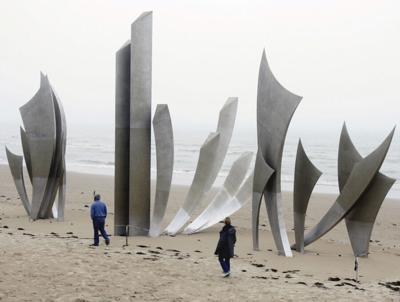After a night at sea, crammed into barges, sickened by the rough seas and exhausted by hours of waiting, “it was terrifying” when the ramp dropped open on Staff Sgt. Irving Locker’s landing craft about 5 yards from the shore of Utah Beach.
A relentless hail of machine gun fire pierced the air between him and a beach laced with mines and barbed wire.
“It was the worst experience I’ve had in my life,” said Locker, of the Village Santiago, who was just 20 years old when his 116th AAA Gun Battalion was dispatched as one of D-Day’s first 90mm gun squads.
“The life we promised ourselves could have been gone with one bullet,” he said. “There but for the grace of God … somebody was watching over us to bring us through.”
At least 2,500 Allied fighters did not make it through that day, and another estimated 10,000 fell wounded.
But wearing 3-pound helmets, bearing 27-pound packs, carrying heavy ammunition across their chests and lugging shovels and other weapons, 150,000 soldiers like Locker pressed forward across 50 miles of French coastline in the largest seaborne invasion in history.
By nightfall, they had taken all five beaches.
For historians, D-Day’s Operation Overlord was the decisive battle in the war against Germany. For those who suffered on the beaches that day, it remains a kaleidoscope of duty, horror and sacrifice.
“There were more dead Americans that day than I had ever seen in my life,” said Locker, who went on to fight in arenas such as the Battle of the Bulge before helping liberate Jewish concentration camps. “I did what I had to do, and I’m grateful to be alive to talk about it.”
In this 75th anniversary year of the end of World War II, few who fought in the great conflict remain to tell the tale. According to the U.S. Department of Veterans Affairs, fewer than 389,000 of the 16 million Americans who served in World War II are alive today.
It is a last legion that stands as a beacon of freedom in veteran strongholds such as The Villages.
‘Young People Do
Extraordinary Things’
Like today’s troops, Locker’s military training was built around daily physical exercises, drills, marching and time spent on the obstacle course and rifle range
But his squad also trained on what then was a radical new technology — radar — to target enemy tanks and aircraft with a 90mm gun.
“We could shoot 30,000 feet, six miles, with deadly accuracy,” Locker said. “This new technology, radar, could tell the height and speed of German aircraft and how far in front to shoot the shell. We had the highest record shooting down planes.”
Meanwhile, other military branches such as the 101st Airborne Division were ramping up training for the D-Day drop behind enemy lines. Not only did the soldiers learn the combat techniques of the classical infantry, they also had to know how to parachute to strategic drops.
“I was sure proud of belonging to them,” said Dale Noble, 95, of the Village Rio Ponderosa. “I was very happy to be assigned to the outfit. I thought a lot of them and the work they were doing. I surely did.”
About 13,000 American paratroopers with the 82nd and 101st airborne divisions boarded 822 transport planes to Utah Beach — while Noble was held back because he hadn’t completed the final phase of his jump training.
An estimated 1,500 drowned in fields the German army had flooded to impede their landing, and another estimated 2,500 were wounded.
“Mainly, it was mass confusion,” Noble said. “No one hit the drop zone. They all hit in the wrong places. They were so far off our target that they resorted to secondary missions they were assigned to hold areas while the landing force was coming in.”
As soon as the surviving 101st came back from Normandy, “we went into training mode back at our base camp,” he said.
That fighting spirit and quest to preserve democracy, is the trait that binds the training of World War II-era veterans with that of today’s armed forces, said retired Army Col. David E. Johnson, an adjunct scholar at the Modern War Institute at the U.S. Military Academy at West Point, New York, and adjunct professor at Georgetown University, Washington, D.C.
“One common bond between them; young people do extraordinary things that you can’t imagine,” he said. “That’s true then, and it’s true now.”
Technology Now Aids
The Way Troops Train
Today’s advanced military training centers have moved away from the forced-push philosophy of the past, said U.S. Sen. Rick Scott, R-Naples, a member of the Senate Armed Services Committee.
“If you look at the difference today, there is a clear focus on keeping every member of the military alive and reducing the risk to any one of them,” said Scott, a U.S. Navy veteran.
Today’s military uses GPS technology to track the health data of every battlefield combatant, said Scott, who served as a radar operator during the Vietnam War on the USS Glover.
“In the second World War, they knew they were going to lose a lot of people,” Scott said. “The big thing that Americans should be impressed with is the focus on all training and technology to keep every military member alive. My dad, a World War II veteran, told me you had to do the best you could to stay together as a unit. That’s totally changed now because of the tracking technology.”
For example, sailors assigned to the USS Zumwalt, the next-generation Navy destroyer, now train on computer simulators that create realistic navigation, sailing and battle conditions.
“Just the training for the jobs is totally different than when I was in the Navy,” Scott said. “So many things are automated with so much information at their fingertips. It’s like night and day from the time my dad and I were in the military.”
Some of that evolution is rooted in Florida, home to 21 military bases and a handful of military training centers.
Orlando’s Central Florida Research Park is the base for a collaborative alliance of Army, Navy, Marine Corps, Air Force, Coast Guard, Joint Forces Command, Department of Homeland Security, National Center for Simulation, Florida High Tech Corridor and the Institute for Simulation & Training at the University of Central Florida.
Modeling, simulation and training is a $6 billion industry for Florida, the group says, employing 30,000 people with an average salary of $78,000.
All of this technology can be traced to what military and political leaders learned from World War II, said George E. Cheros, the center’s president and CEO.
“D-Day was the impetus for all of this technology,” said Cheros, whose father served as an intelligence officer during World War II.
Today’s military is much better trained going into battle, said G. Kurt Piehler, associate professor of history at Florida State University and director of the Institute on World War II & The Human Experience.
“The biggest difference since D-Day and today’s military is the professionalism,” he said. “World War II was a draft military. The biggest shift is the Army infantry is no longer a dumping ground for recruits. We now put some of our best officers in the infantry. The training is much more consistent. World War II did this remarkable mobilization, but sometimes desperation took men directly from basic training and sent them to war.”
From Video Games
To The Battlefield
Over the past several decades, officials also discovered that sophisticated video games employing artificial intelligence have applications to military training, Cheros said.
“They can literally put on a set of virtual reality goggles, with all the GPS technology,” he said. “Then they put them in a large conference room, change the climate and add sounds and smells to trigger the senses. With a VR headset they could visually be walking the streets of Baghdad, Iraq, during a war exercise, watching a sniper set up to shoot them, and they can fire back. So, as opposed to D-Day, where you take off and go shoot your way through it, our soldiers are a lot more prepared.”
For example, a cadet in a flight simulator at the Naval Air Station Jacksonville can virtually fly along in F-35s — the Army, Navy and Marines’ next generation of U.S. joint strike fighter jets.
“He feels like he’s part of the group,” Cheros said. “He’s communicating with them. Take it one step farther, and that cadet can interact with Navy ships below. He gets that training interaction with the pilots, but also with other assets in the area. It’s amazing what they’re doing out there.”
Just 20 years ago, all of the big training exercises were conducted on military bases or remote locations in large simulators before squadrons were sent into the field.
“With this new technology, they can send the training with portable devices to the war fighter no matter where they are,” Cheros said. “The information can be transmitted, with all appropriate safeguards, to an iPhone or other apparatus. With virtual reality goggles, they can train on whatever mission they’ll be on the next day, the next week.”
Computer simulation training enhances the muscle memory in the same way golfers and ball players practice, said Army Major Ken Truesdale, deputy operations chief at the Army Futures Command Synthetic Training Environment Cross Functional Team at the Central Florida Research Park.
“The more you repeat it the better you get at it. The great thing now is you can put multiple situations in front of you before you step out on the battlefield. They grew up with video games,” he said. “So, we’re giving them something that they’re used to. We’re not introducing anything new to them.”
At the same time, “We can’t get away from how we train naturally,” he said. “You have to have basic soldier skills training at the rifle ranges, the maneuvers in the woods.”
The technology also benefits military trainers, Truesdale said.
“We’re able to see individuals train, but with a better vision of how we interact collectively; and that particularly helps the non-commissioned officers,” he said. “It also lets us train on things we wouldn’t normally be able to do.”
Emerging technologies such as artificial intelligence, hypersonics, machine learning, nanotechnology, and robotics may revolutionize tomorrow’s battlefields the way machine guns, tanks and aviation did in World War II.
Even today’s 3D mapping technology would have drastically changed the Normandy invasion by spotting large hedgerows that bogged down troops after the beaches.
Today’s training is delivered to the point of need, said Army Master Sgt. Nhiem Chau, the Synthetic Training Environment team’s senior noncommissioned officer. “It’s easy to put together the tools at their fingertips. A squad leader could set up battle drills in about 30 minutes and have a virtual platform on which to train. It’s a huge advantage.”
Even without those advantages, Locker said he and his fellow D-Day veterans simply did what they felt compelled to do.
“I’m not a hero, as far as I’m concerned,” Locker said. “A lot of people were willing to give up their life to protect the American people. There were a lot of people who gave their lives, millions of people gave their lives so the children today could be free.”
Senior writer David R. Corder can be reached at 352-753-1119, ext. 5241, or david.corder@thevillagesmedia.com.











Commented
Sorry, there are no recent results for popular commented articles.